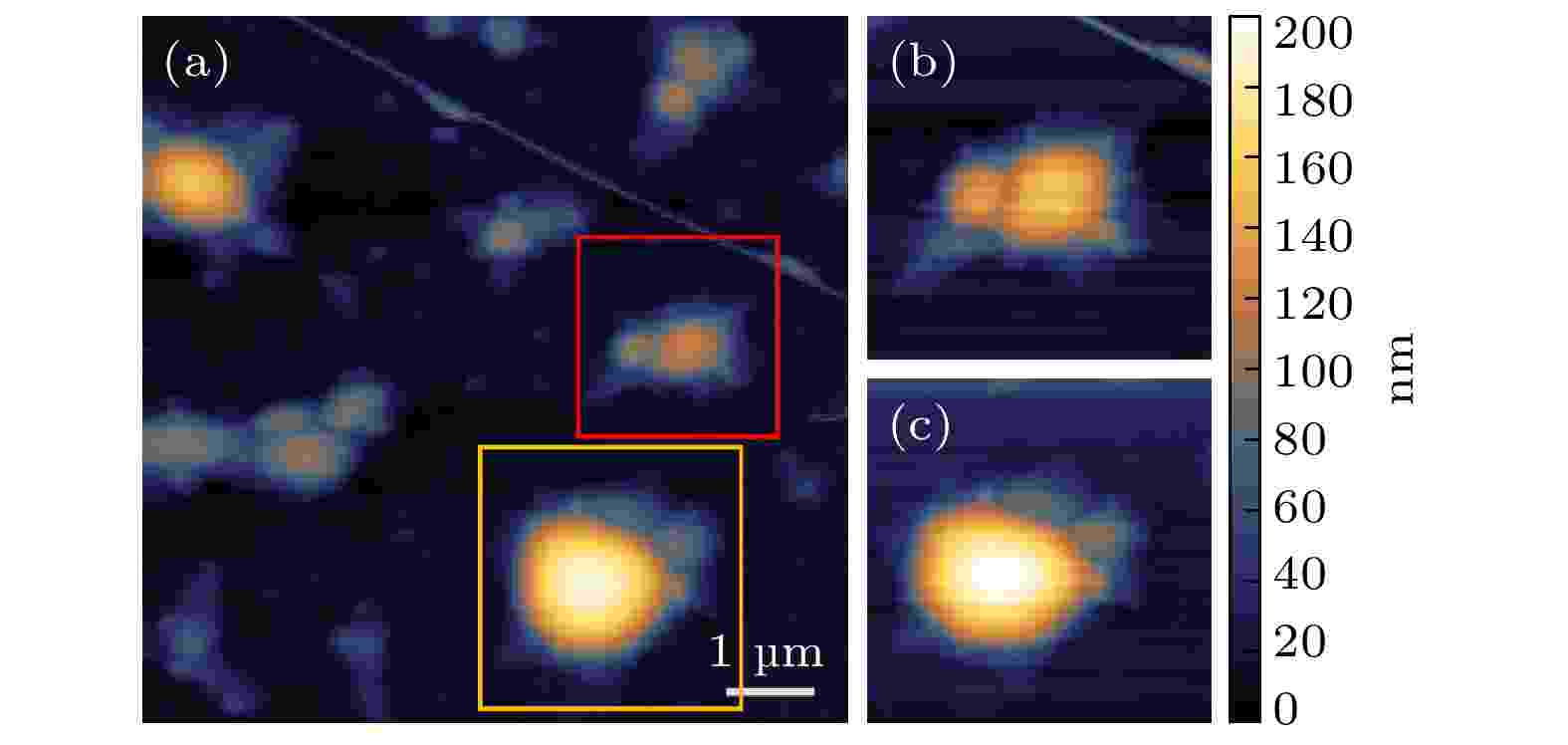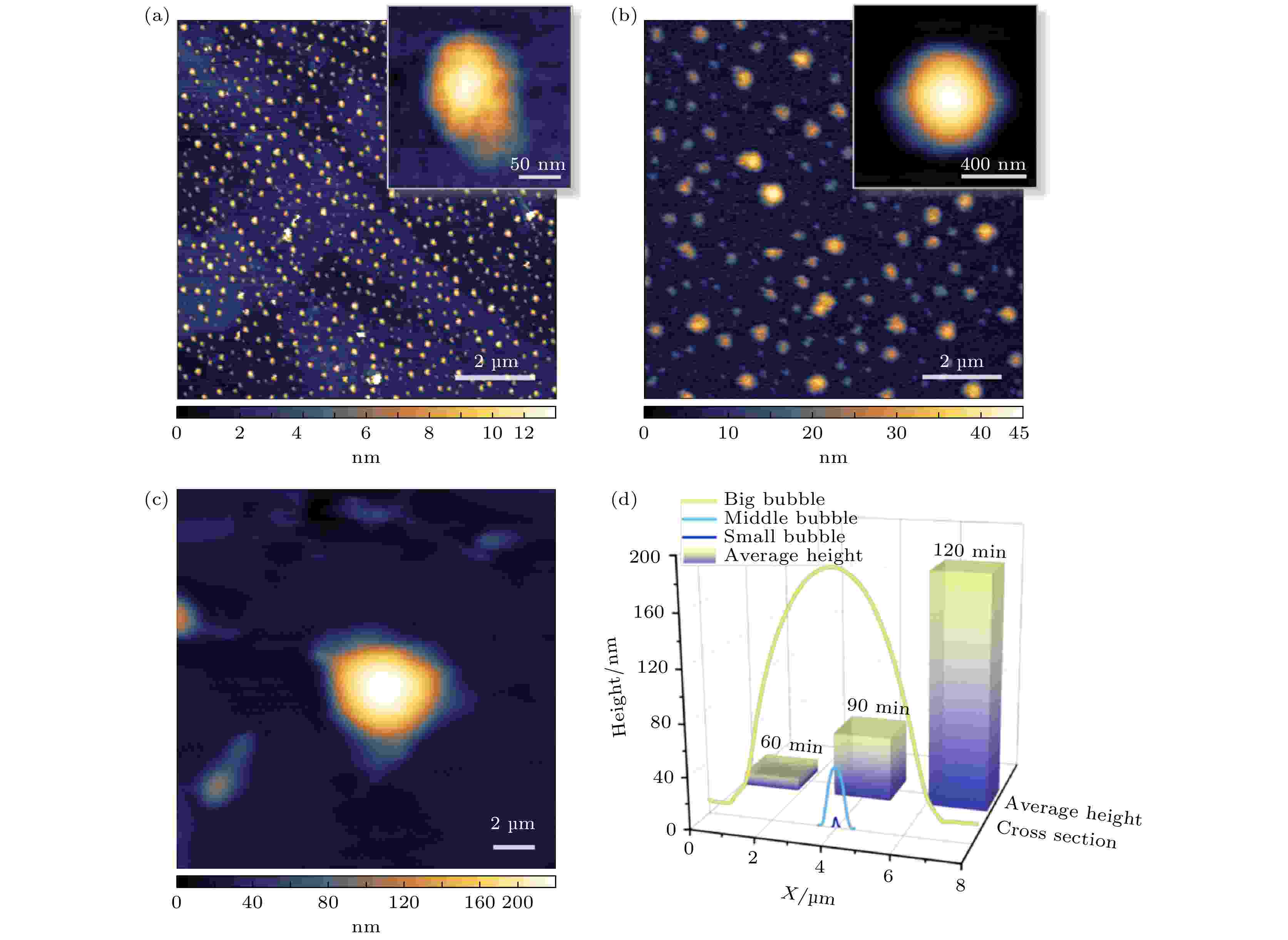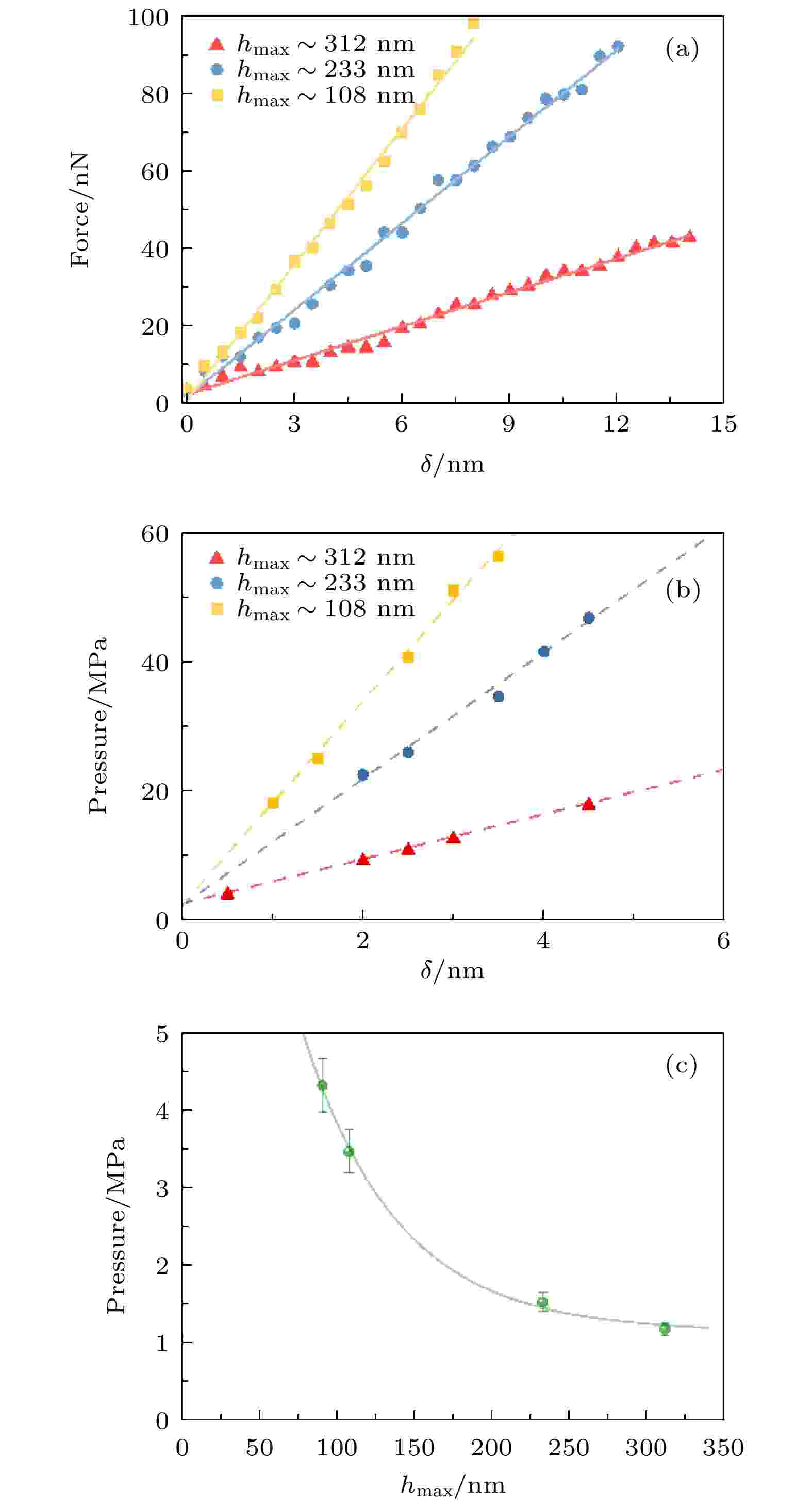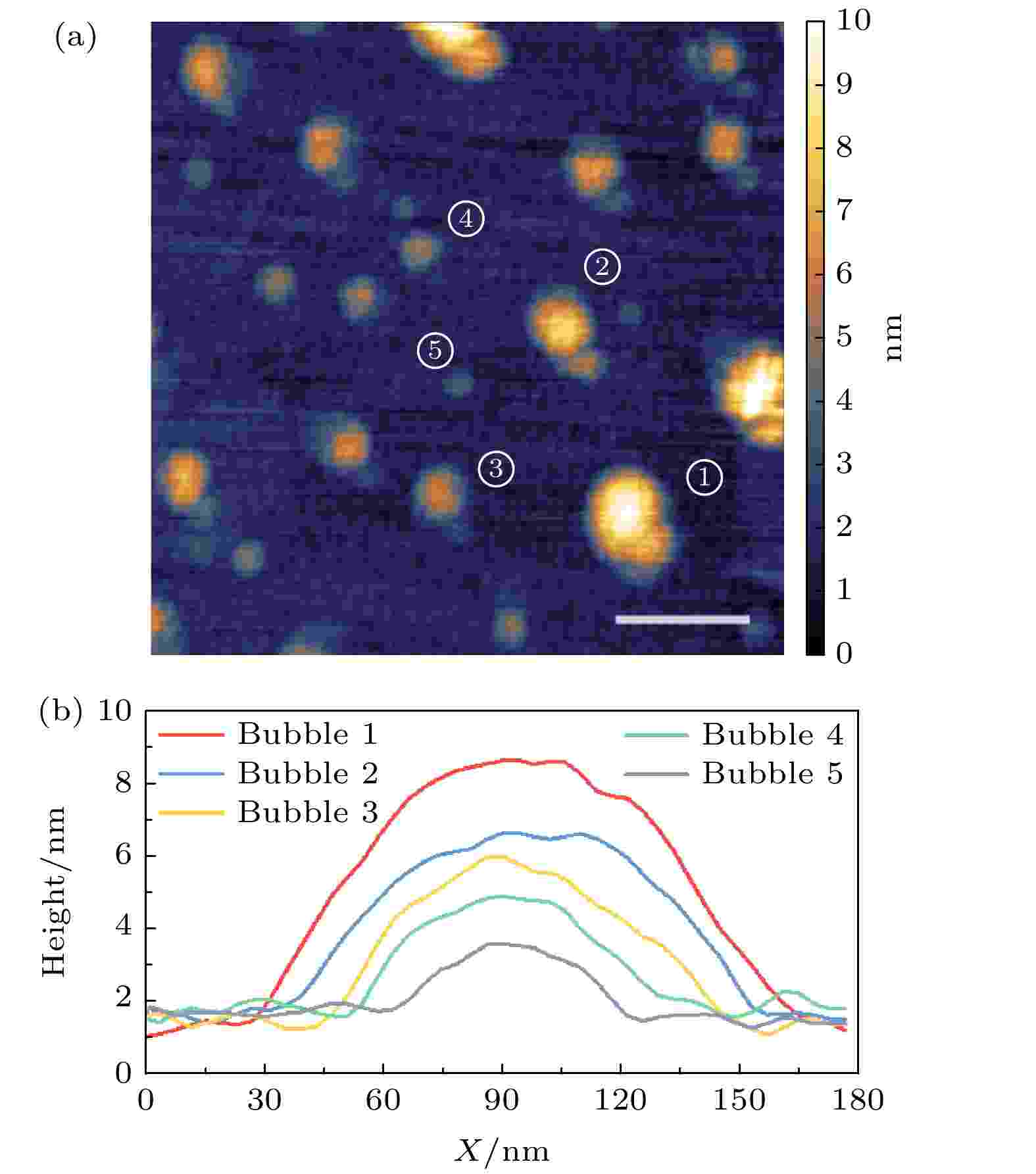全文HTML
--> --> -->与石墨烯材料类似[9], h-BN具有较高的弹性且可以封装气体分子. 得益于h-BN合适的晶格常数和堆垛结构[10], 气体分子难以穿透h-BN晶格[11], 因此气体可以在被捕获后保存在h-BN气泡中. 目前, 许多二维材料(例如石墨烯[12–17]和二硫化钼[12,13,18–20]等)均被用来尝试制备纳米气泡结构. 然而, 针对这种纳米气泡结构的制备, 大部分方案还停留在将机械剥离的二维材料薄层转移到衬底过程中的小概率气体捕获方案, 气泡结构的制备具有随机性且产率不高. 此外, 相关性质研究大多集中于石墨烯等二维材料, 针对h-BN气泡结构的制备和研究较少.
最近, 作者所在课题组通过直接对h-BN片层进行氢等离子体处理, 实现了h-BN气泡的制备[21], 但h-BN纳米气泡的形貌和机械特性有待研究. 本文通过改变氢等离子体处理时间, 研究了h-BN气泡尺寸随处理时间的关系. 在气泡机械性质方面, 通过对h-BN气泡结构的原子力显微镜(AFM)测量发现气泡高度和气泡半径的比值几乎是恒定的. 理论分析发现该比值仅与h-BN材料的杨氏模量以及层间的范德瓦耳斯(vdW)相互作用有关. 为了得到h-BN纳米气泡内的气体压强, 采用了AFM的纳米压痕技术[22–27]对气泡进行力-位移曲线的测量. 分析发现气泡内部的压力与层间vdW相互作用和气泡的最大高度有关.
等离子体处理时间控制在90—150 min. 在氢等离子体处理期间, 氢气分子被离子化为氢离子或原子, 这些氢离子或原子足够小且具有数个电子伏(eV)的动能, 足以无损穿过h-BN的晶格, 最后在h-BN片层表面形成氢气气泡, 这些气泡区域的h-BN通常为多层, 厚度约为6 nm[21].
可以通过AFM (Cypher S, Asylum Research)测量得到h-BN气泡的形貌特征. 图1为氢等离子体处理后在h-BN气泡的AFM形貌图. 几乎所有气泡都具有圆形或近似圆形的基底(图1(a)). 在气泡分布较密集的区域, 气泡间距比较近. 这些气泡通常较小, 半径小于300 nm (图1(b)). 对于尺寸较大的气泡, 它们的半径可达到约600 nm (图1(c)).
 图 1 h-BN气泡的典型AFM形貌图像 (a) 具有不同尺寸以及不同分布密集程度的h-BN纳米气泡形貌图像(标尺: 1 μm); (b), (c) 分别是图(a)中红色和橙色线框区域的放大AFM测量形貌图; 所有形貌图像共享右侧的标尺
图 1 h-BN气泡的典型AFM形貌图像 (a) 具有不同尺寸以及不同分布密集程度的h-BN纳米气泡形貌图像(标尺: 1 μm); (b), (c) 分别是图(a)中红色和橙色线框区域的放大AFM测量形貌图; 所有形貌图像共享右侧的标尺Figure1. Typical AFM images of h-BN bubbles: (a) Topography of h-BN bubbles in different size and distribution density. Scale bar, 1 μm; (b), (c) AFM images taken from the red and orange box in panel (a) respectively. The scale of height sits on the right.
所有的h-BN气泡样品在大气环境中进行保存, 以探索其结构随时间的稳定性. 通过在不同时间段对相同样品区域的光学显微镜测量(补充材料的图S1 (
 图 2 氢等离子体处理不同时间后h-BN气泡分布情况 (a)?(c) 氢等离子体处理60, 90和120 min时, h-BN表面的气泡情况(标尺: 2 μm), 图(a)和图(b)中的插图分别是对应处理时间的单个气泡的AFM形貌图像, 图(a)插图的标尺为50 nm, 图(b)插图的标尺为400 nm; (d) 图(a)和图(b)的插图以及图(c)的气泡截面轮廓, 柱状图部分是在不同处理时间下气泡平均高度的统计
图 2 氢等离子体处理不同时间后h-BN气泡分布情况 (a)?(c) 氢等离子体处理60, 90和120 min时, h-BN表面的气泡情况(标尺: 2 μm), 图(a)和图(b)中的插图分别是对应处理时间的单个气泡的AFM形貌图像, 图(a)插图的标尺为50 nm, 图(b)插图的标尺为400 nm; (d) 图(a)和图(b)的插图以及图(c)的气泡截面轮廓, 柱状图部分是在不同处理时间下气泡平均高度的统计Figure2. Distribution of h-BN bubbles after hydrogen plasma treatment for different treatment duration. (a)?(c) AFM images of the h-BN bubbles after treated for 60, 90 and 120 min. Scale bar: 2 μm. The inserts in (a) and (b) are the AFM topography images of a single bubble corresponding to the processing time. The scale bar is 50 nm for insert in (a) and 400 nm for the insert in (b). (d) Cross-sectional profiles of bubbles in inserts of panels (a) and (b) and panel (c). The histogram part is the average bubble height under different processing times according to statistics.
图2(a)所示是氢等离子体处理时间为60 min的情况, h-BN表面分布着密集的气泡, 他们具有很小的尺寸, 半径在40—50 nm, 高度仅有几纳米. 将处理时间延长到90 min后, 气泡的分布情况如图2(b)所示. 气泡分布的密集程度相比处理时间为60 min时有所降低, 但气泡尺寸明显增大, 半径达到500—600 nm, 且气泡高度达到了50 nm. 图2(c)反映的是处理时间为120 min的气泡分布情况, 气泡的半径达到了3 μm, 并且气泡最大高度有200 nm左右. 图2(a)—(c)中的标尺均表示2 μm的尺度. 综合来看, 处理时间的延长会使得气泡的尺寸增大且气泡分布的密集程度降低. 气泡密集程度的降低是由于在气泡持续增大的过程中, 相邻的气泡发生了合并, 这一点在图2(c)中尤为明显, 大气泡的周围有零散的尺寸较小的气泡.
为了清楚地分辨小尺寸的气泡, 图2(a)和图2(b)的插图中给出了对应处理时间的单独h-BN气泡AFM形貌图, 这直观地反映出处理时间的延长会使得气泡尺寸增大. 图2(a)和图2(b)插图中的气泡截面轮廓和图2(c)中的气泡轮廓统一在图2(d)中进行比较. 随着处理时间的延长, 气泡的形貌是整体扩大的过程, 气泡半径以及高度都随着处理时间的增加而增大. 图2(d)中的柱状图部分是对不同处理时间下气泡平均高度的统计. 气泡的高度在处理时间延长的情况下会整体增大. 因此, 延长氢等离子体处理时间有利于形成更大的h-BN气泡.









 图 3 气泡特征尺寸的统计分析 (a) 对不同半径气泡的尺寸比统计结果, 插图是h-BN气泡的结构示意图; (b) 具有不同尺寸比的气泡数量统计, 可以发现h-BN气泡的尺寸比集中在0.092附近, 橙色点代表气泡的尺寸比与0.092的偏差, 整体偏差值在10%范围以内(绿色区域)
图 3 气泡特征尺寸的统计分析 (a) 对不同半径气泡的尺寸比统计结果, 插图是h-BN气泡的结构示意图; (b) 具有不同尺寸比的气泡数量统计, 可以发现h-BN气泡的尺寸比集中在0.092附近, 橙色点代表气泡的尺寸比与0.092的偏差, 整体偏差值在10%范围以内(绿色区域)Figure3. Characteristic analysis of bubbles. (a) Statistical results of size ratios hmax/R of bubbles with different radius. The inset is a schematic diagram of the h-BN bubble structure. (b) Statistics of bubble numbers with different size ratios. It can be found that the size ratio of h-BN bubbles is concentrated around 0.092. The orange point represents the deviation of the bubble size ratio from 0.092, and the overall deviation value is within 10% (green area).
对此, 我们对h-BN气泡的形成过程进行了分析: 电离后的氢原子(离子)穿过网状h-BN晶格, 在层间结合成氢气分子从而形成气泡结构. 该气泡结构的气压会导致气泡区域的顶部h-BN发生拉伸形变. 最终, 气泡内外气压差、h-BN的形变张力和h-BN层间vdW作用力形成平衡.
顶部h-BN通过vdW相互作用与h-BN衬底相结合. h-BN在气泡边缘的相互作用主要是vdW力、内外气压差以及h-BN因形变导致的刚度张力相互竞争的结果. h-BN的刚度由面内应力和与面外弯曲相关的能量共同决定. 其中, 面内应力可以由弹性理论[30]进行描述. 由于h-BN的结构与石墨烯相似, 面外形变会对面内刚度产生影响, 而面外弯曲程度可以通过弯曲刚度来进行描述. 面内应力和弯曲刚度对弹性能量的贡献取决于材料的形变尺度. 若形变尺度超过



为了实际测量h-BN气泡中的气体压强, 利用AFM的纳米压痕技术对气泡进行力-位移曲线的测量. 使用AFM探针在小距离范围内下压不同尺寸的气泡, 并记录相应的力-位移曲线(FDC). 为了避免在探针下压过程中破坏h-BN气泡, 设定了较小的探针压痕深度(约为15 nm). 图4(a)显示了不同尺寸气泡的FDC. 该图反映出随着气泡尺寸的增加, 要达到相同的下压深度(


 图 4 h-BN气泡内压强的分析 (a) 通过AFM测得的不同尺寸的h-BN气泡的力-位移曲线, 随着探针下压深度的增加, 所需的力也随之增大, 不同尺寸气泡的力-位移曲线表现出不同的斜率; (b) 从实际测得的力-位移数据中提取的vdW压强随探针下压深度的关系, 虚线为对应数据组的线性拟合结果; (c) vdW压强与气泡最大高度hmax的关系图, 实线部分是针对1/hmax的非线性拟合结果
图 4 h-BN气泡内压强的分析 (a) 通过AFM测得的不同尺寸的h-BN气泡的力-位移曲线, 随着探针下压深度的增加, 所需的力也随之增大, 不同尺寸气泡的力-位移曲线表现出不同的斜率; (b) 从实际测得的力-位移数据中提取的vdW压强随探针下压深度的关系, 虚线为对应数据组的线性拟合结果; (c) vdW压强与气泡最大高度hmax的关系图, 实线部分是针对1/hmax的非线性拟合结果Figure4. Pressure analysis inside h-BN bubbles. (a) Force-displacement curves of the bubbles with different sizes are measured by AFM, which shows the force increases while the tip goes deeper. The FDCs of different-sized bubbles have diverse slopes. (b) vdW pressure inside bubbles extracted from the experimental data in panel (a) as a function of the indentation depth. Dashed lines are linear fits. (c) vdW pressure as a function of


在AFM探针尖端的下压过程中, AFM系统检测到的力可能不仅来自气泡内部封装气体, 还来自顶部h-BN形变所产生的弹力. 施加到探针的力(F)和
















除了上述分析的尺寸在微米级的气泡, 在处理时间较短时, h-BN表面会得到较多纳米级的小尺寸气泡. 图5描述了典型的小气泡AFM形貌图像, 其在h-BN表面分布较密集, 气泡半径在几十纳米范围. 通过AFM图像的界面轮廓, 测得气泡高度仅有几纳米.
 图 5 在短时间氢等离子体处理下得到的小尺寸气泡 (a) 小尺寸气泡的分布情况(标尺: 150 nm); (b) 图(a)中标有数字记号的小气泡截面轮廓图
图 5 在短时间氢等离子体处理下得到的小尺寸气泡 (a) 小尺寸气泡的分布情况(标尺: 150 nm); (b) 图(a)中标有数字记号的小气泡截面轮廓图Figure5. Small size bubbles obtained under short-time hydrogen plasma treatment: (a) The distribution of small size bubbles, the size scale is 150 nm; (b) the cross-sectional profile view of the small bubbles marked with numbers in panel (a).
对于该小尺寸的纳米气泡, 使用AFM纳米压痕技术很难对其内部压强进行测量, 主要原因有两个方面: 1)要获得较理想的纳米压痕曲线, AFM探针针尖至少需要在气泡区域下压5—15 nm的距离, 对于小尺寸气泡, 该下压距离已经超出了气泡的最大高度, 难以有效捕捉探针下压时的力-位移信号; 2)对于小尺寸气泡, 其横向尺度已经可以和探针的尖端半径可比, 在分析时就必须考虑针尖下压过程中, 针尖与气泡表面接触面积的变化, 这意味着上面分析的模型将不适用于小尺寸的气泡.
尽管难以对小尺寸气泡进行纳米压痕测量, 不过有研究人员已经报道了小尺寸纳米气泡的压强与其特征尺寸的理论关系[13]. 气泡内气体压强与气泡最大高度的关系满足

6.1.原子力显微镜测量
h-BN气泡的形貌图像和力-位移曲线通过Cypher AFM (Asylum Research)进行测量. 使用具有较软悬臂的探针(弹簧系数

对h-BN气泡的尺寸统计发现其表现出一般特征, 该特征仅由h-BN的弹性性质决定. AFM测量结果表明, 不同尺寸的气泡具有相同的尺寸比. 分析指出该尺寸比仅受层间vdW相互作用和h-BN的弹性性能的影响.
在h-BN气泡上进行AFM纳米压痕测量, 以研究气泡内部的气体压强. 发现压力与尖端压痕深度呈线性关系, 与理论分析相符合. 气泡内气体压强与气泡高度之间的关系表明, 较高的气泡通常会具有较低的压强. 对于微米尺度的h-BN气泡, 捕获在气泡内部的氢气压强有1—2 MPa. 而对于尺寸仅有几纳米的小气泡, 其内部气体压强经估算能达到0.1—0.5 GPa.
